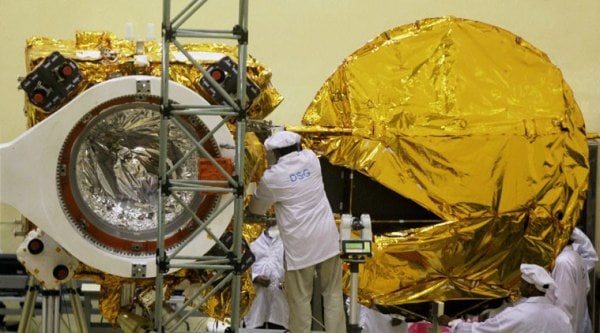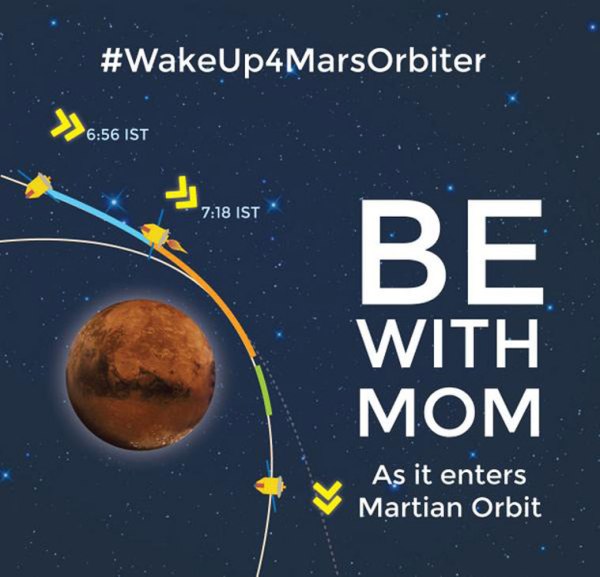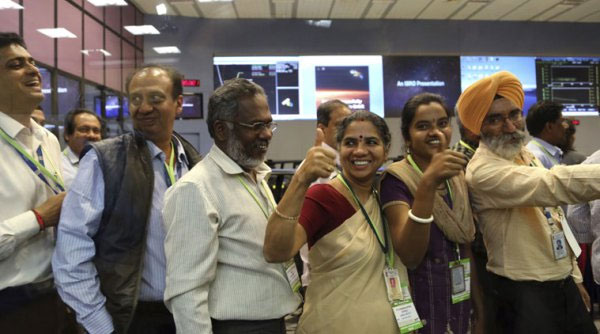- India
- International
India becomes first nation to put spacecraft in Mars orbit in maiden attempt
India is the first country in the world to make it to the Red Plant in the first attempt.
 Indian scientists at ISRO preparing the Mars Orbiter. India became the first country on Wednesday to put the spacecraft into Mars orbit in the first attempt.
Indian scientists at ISRO preparing the Mars Orbiter. India became the first country on Wednesday to put the spacecraft into Mars orbit in the first attempt.
India scripted space history on Wednesday as the Indian Space Research Organisation (ISRO) successfully inserted its low-cost Mars Orbiter Mission (MOM) spacecraft, or Mangalyaan, into an orbit around the Red Planet in its very first attempt.
This puts ISRO in the elite league of NASA, the European Space Agency and the erstwhile Soviet Union for carrying out successful missions to Mars.
The insertion into Mars’s orbit went perfectly as planned, with the spacecraft executing on cue the time tagged commands loaded to its computer system 10 days ago by mission scientists from the Mission Operations Centre (MOX) at ISRO’s Telemetry, Tracking and Command (ISTRAC) facility in Peenya in north Bangalore.
 (Source: ISRO)
(Source: ISRO)
“The spacecraft is now circling Mars in an orbit whose nearest point to Mars (periapsis) is at 421.7 km and farthest point (apoapsis) is at 76,993.6 km. The inclination of orbit with respect to the equatorial plane of Mars is 150 degree, as intended. In this orbit, the spacecraft takes 72 hours 51 minutes 51 seconds to go around Mars once,’’ said ISRO in its official statement in the evening.
Earlier in the day, the successful mission — with Prime Minister Narendra Modi in attendance — was greeted by cheers from scientists at ISRO’s Mission Operations Centre 2 (MOX 2).


“If our national cricket team wins a tournament, the whole country celebrates. What our scientists have done is far greater,’’ said Modi. Appreciating the low-cost nature of the project — at $74 million, it costs less than the $100 million Hollywood movie Gravity — he called on scientists to continue to push their boundaries further.
Stating that India had achieved the “near impossible,” Modi said, “The odds were stacked against us. Of the 51 missions attempted across the world so far, a mere 21 had succeeded. But we have prevailed… Today MOM has met Mangal (Mars). Today Mangal has got MOM. When the short form of the mission became MOM, I was sure that MOM would not disappoint us.”
The orbit insertion occurred after a 24.23 minute firing of the main liquid engine onboard the orbiter, between 7.17.32 AM IST (time on board spacecraft) and 7.41.46 AM IST, to impart a velocity of 1,099 metres per second to slow down the spacecraft and synchronise it with the 25.71 kilometres per second velocity of Mars.
The velocity imparted was marginally more than the 1,098 metres per second required by the spacecraft to sit in an orbit measuring 423 km x 80,000 km around the Red Planet, and, according to initial calculations, placed the spacecraft around 427 km away from Mars. “The determination of the orbit that it has been placed in is continuing and the final position will be known only on Thursday,’’ said ISTRAC Deputy Director M Pitchamani.
The Mangalyaan’s orbit is much further and larger than the 150 km x 6250 km orbit achieved by NASA’s Maven spacecraft, which was inserted 48 hours prior to the arrival of ISRO’s MOM spacecraft.
There were loud cheers at the main mission control facility monitoring the spacecraft when data was received at 7.30 AM IST (after a 12.5 minute delay on account of the 224 million km radio communication distance) that the liquid engine on the spacecraft had started on the dot at 7.17 AM IST, indicating that the orbit insertion was going as per the pre-determined schedule.
The loudest cheers came at 8.09 AM IST, when data transmitted from Mangalyaan reported that the liquid engine had imparted the requisite power to the spacecraft.
During the orbit insertion exercise on Wednesday, there was a 20 minute period of darkness when communication with the spacecraft was shut down due to the orbiter being eclipsed by Mars. The spacecraft functioned on internal battery mode until the end of the eclipse at around 7.37 AM, when solar charging of the batteries resumed and onboard communication was switched on.
The biggest concern in the exercise was whether the autonomous spacecraft would execute the commands loaded 10 days ago from Earth and whether the engine would fire on cue.
“We have been loading commands to the spacecraft for the last 10 months that it has been on its 666 million km journey to Mars. Still it was a great sense of achievement when the sequences activated. Communicating over such a large distance is new to us,’’ said Pitchamani.
“When we received data for four minutes of engine firing at 7.30 AM — before the communication shutdown began — we saw that the engine had provided a velocity of 177 metres per second. This was the number we wanted and it gave a huge reassurance,’’ said ISTRAC scientist Pamadeo Mishra.
“The liquid engine on the spacecraft has marginally over performed, but in an overall sense the Mars insertion went to plan and the spacecraft retains a small amount of fuel for small corrections using eight small thrusters that worked in conjunction with the main engine,’’ said Dr K Sivan, the director of the Liquid Propulsion Systems Centre.
“Waking up an engine that has been sleeping for 300 days and getting an optimum performance from it was the big challenge. We have achieved that,’’ he said.
The Indian Mars mission was launched on November 5, 2013 on board ISRO’s workhorse rocket the PSLV. After six Earth-bound orbit raising maneuvers, the spacecraft was inserted into a transfer orbit to Mars on December 1, where the spacecraft cruised through deep space using the heliocentric force for propulsion instead of the main liquid engine that was put in cold storage for operations to be carried out today.
More Tech
Apr 25: Latest News
- 01
- 02
- 03
- 04
- 05










































